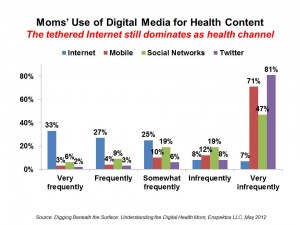 Mom is the Chief Health Officer of her family, she’s mobile, and seeking health information and community on-the-go.
Mom is the Chief Health Officer of her family, she’s mobile, and seeking health information and community on-the-go.
But underneath the persona of the Mobile Mom, she’s consuming information and sharing perspectives on many other ‘screens,’ too. And that’s the challenge for marketers seeking to grab the attention of this key player in the health ecosystem.
There are new survey data from Enspektos‘s report, Digging Beneath the Surface: Understanding the Digital Health Mom, that are must-reading for health industry stakeholders who seek to motivate health behaviors among women, who are at once nurturing wellness, caregiving for sick people, and sharing opinions about health products and services in their social networks. In health and health care, Sisters are doing it for themselves and for their loved ones.
As a Chief Health Officer, 86% of Moms make the decision about which remedies her family uses. Two-thirds trust pediatricians but still go online before and after doctor’s visits to do their own research, according to BabyCenter. Mom is tech-savvy: one-half of online moms own smartphones and among these, 40% have downloaded health and wellness apps, and go social via mobile. The emergence of Pinterest has mobile moms sharing images and ideas: Pinterest users are predominantly female, between the age of 25 and 44: the sweet spot of mothering young children. 95% of Moms overall are Internet users, and 76% of Moms are social network users, according to Emarketer’s projections based on the Women in the Labor Force report from the Bureau of Labor Statistics.
In health, social networking exerts a powerful force on Moms, 53% of whom say social networks influence their opinions on health and wellness.
Health Populi’s Hot Points: Mom’s a multi-screen consumer, as the chart illustrates. And the Internet continues to be the dominant health channel. Enspektos suggests that content providers looking to get Mom’s attention must “penetrate Moms’ filters” because only the most relevant and compelling content gets into her bandwidth.
There are two over-arching considerations here:
1. Health competes for Mom’s bandwidth with other priorities. Within health, different health content compete for attention. Understanding how Mom prioritizes, then how she values and ultimately acts on different health content areas, is one key to motivating a behavior.
2. The rush to mobile, without an overall strategic objective for an outcome, will waste resources and add to the growing roster of mobile health apps that may get downloaded, but not sustained use.
Remember that Mom is multi-screen, multi-priority, and uber-busy. Carefully thinking through health objectives, and then developing a communications strategy that integrates messages across comms platforms, will yield a far greater ROI (and ultimately behavior change) than a one-off, ready-fire-aim slick health app.




 Interviewed live on BNN Bloomberg (Canada) on the market for GLP-1 drugs for weight loss and their impact on both the health care system and consumer goods and services -- notably, food, nutrition, retail health, gyms, and other sectors.
Interviewed live on BNN Bloomberg (Canada) on the market for GLP-1 drugs for weight loss and their impact on both the health care system and consumer goods and services -- notably, food, nutrition, retail health, gyms, and other sectors. Thank you, Feedspot, for
Thank you, Feedspot, for  As you may know, I have been splitting work- and living-time between the U.S. and the E.U., most recently living in and working from Brussels. In the month of September 2024, I'll be splitting time between London and other parts of the U.K., and Italy where I'll be working with clients on consumer health, self-care and home care focused on food-as-medicine, digital health, business and scenario planning for the future...
As you may know, I have been splitting work- and living-time between the U.S. and the E.U., most recently living in and working from Brussels. In the month of September 2024, I'll be splitting time between London and other parts of the U.K., and Italy where I'll be working with clients on consumer health, self-care and home care focused on food-as-medicine, digital health, business and scenario planning for the future...